Related Research Articles

Wilberforce University is a private historically black university in Wilberforce, Ohio. Affiliated with the African Methodist Episcopal Church (AME), it was the first college to be owned and operated by African Americans. It participates in the United Negro College Fund.

William Holmes McGuffey was an American college professor and president who is best known for writing the McGuffey Readers, the first widely used series of elementary school-level textbooks. More than 120 million copies of McGuffey Readers were sold between 1836 and 1960, placing its sales in a category with the Bible and Webster's Dictionary.

Lane Seminary, sometimes called Cincinnati Lane Seminary, and later renamed Lane Theological Seminary, was a Presbyterian theological college that operated from 1829 to 1932 in Walnut Hills, Ohio, today a neighborhood in Cincinnati. Its campus was bounded by today's Gilbert, Yale, Park, and Chapel Streets.
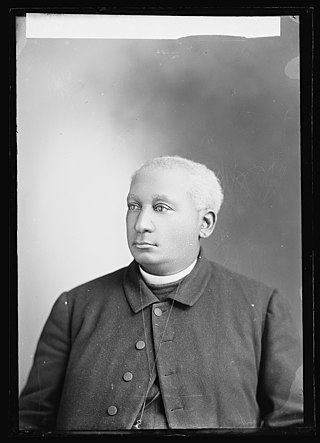
Benjamin William Arnett was an American educator, minister, bishop and member of the Ohio House of Representatives.

John Mercer Langston was an American abolitionist, attorney, educator, activist, diplomat, and politician. He was the founding dean of the law school at Howard University and helped create the department. He was the first president of what is now Virginia State University, a historically black college. He was elected a U.S. Representative from Virginia and wrote From the Virginia Plantation to the National Capitol; Or, the First and Only Negro Representative in Congress From the Old Dominion.

Edward Alexander Bouchet was an American physicist and educator and was the first African American to earn a Ph.D. from any American university, completing his dissertation in physics at Yale University in 1876. On the basis of his academic record he was elected to the Phi Beta Kappa Society. In 1874, he became one of the first African Americans to graduate from Yale College.
Cincinnati Public Schools is the U.S. state of Ohio's third-largest public school district, by enrollment, after Columbus City Schools and Cleveland Metropolitan School District. Cincinnati Public Schools is the largest Ohio school district rated as 'effective'. Founded in 1829 as the Common Schools of Cincinnati, it is governed by the Cincinnati Board of Education.
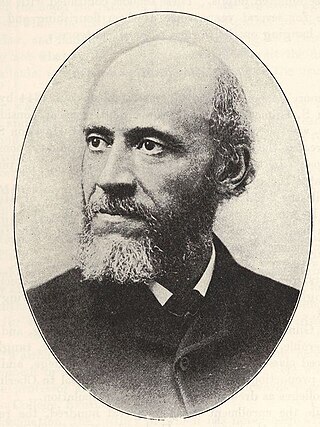
Peter Humphries Clark was an American abolitionist and speaker. One of Ohio's most effective black abolitionist writers and speakers, he became the first teacher engaged by the Cincinnati black public schools in 1849, and the founder and principal of Ohio's first public high school for black students in 1866. Because of these accomplishments, he was named the nation's primary black public school educator. Clark is also remembered as the first African-American socialist in the United States, running for Congress in 1878 under the banner of the Socialist Labor Party of America.
The history of education in the United States covers the trends in formal educational in America from the 17th century to the early 21st century.
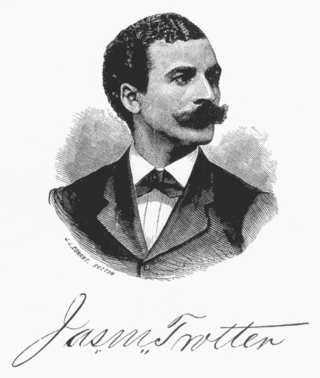
James Monroe Trotter was an American teacher, soldier, employee of the United States Post Office Department, a music historian, and Recorder of Deeds in Washington, D.C. Born into slavery in Mississippi, he, his two sisters and their mother Letitia were freed by their master, the child's father, and helped to move to Cincinnati, Ohio. He grew up in freedom, attending school and becoming a teacher.

Inez Beverly Prosser was a psychologist, teacher and school administrator. She is often regarded as the first African-American female to receive a Ph.D in psychology. Her work was very influential in the hallmark Brown v. Board of Education Supreme Court ruling. After growing up in Texas, Prosser was educated at Prairie View Normal College, the University of Colorado and the University of Cincinnati. She was killed in a car accident a short time after earning her doctorate.

Rev. John Keep was a trustee of Oberlin College from 1834 to 1870. Keep and William Dawes toured England in 1839 and 1840 gathering funds for Oberlin College in Ohio. They both attended the 1840 anti-slavery convention in London.
Hiram Wilson was an anti-slavery abolitionist who worked directly with escaped and former slaves in southwestern Ontario. He attempted to improve their living conditions and help them to be integrated into society by providing education and practical working skills. He established ten schools to educate free blacks in southwestern Ontario. Wilson worked extensively with Josiah Henson to establish the British-American Institute and the Dawn Settlement in 1841. He was a delegate to the World Anti-Slavery Convention of 1843 in London, England. He resigned from the British-American Institute and moved to St. Catharines, Ontario, where his home was a final terminal for the Underground Railroad.
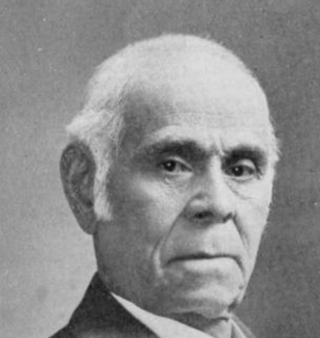
James Madison Bell was an African-American poet, orator, and political activist who was involved in the abolitionist movement against slavery. He was the first native African-American poet in Ohio and was called the "Bard of the Maumee," of Maumee River. According to Joan R. Sherman: "As poet and public speaker, Bell was one of the nineteenth century's most dedicated propagandists for African-American freedom and civil rights."

Joseph Carter Corbin was a journalist and educator in the United States. Before the abolition of slavery, he was a journalist, teacher, and conductor on the Underground Railroad in Ohio and Kentucky. After the American Civil War, he moved to Arkansas where he served as superintendent of public schools from 1873 to 1874. He founded the predecessor of University of Arkansas at Pine Bluff and was its first principal from 1875 until 1902. He ended his career in education spending a decade as principal of Merrill High School in Pine Bluff. He also taught in Missouri.
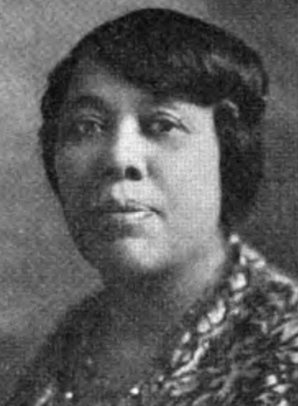
Jennie Davis Porter was an American educator. She was the first African-American to receive a PhD from the University of Cincinnati and became the first black female principal of a public school in Cincinnati. In 1989, she was posthumously inducted into the Ohio Women's Hall of Fame.

Edward J. Sanderlin was born into slavery. He was in Cincinnati by 1850, where he attended the Gilmore School. He took part in the California Gold Rush and the Pike's Peak Gold Rush in Colorado. He operated a barbershop and restaurant in Denver in its early frontier days. He became a wealthy businessman and investor in mines in Colorado and California.
Gaines High School was a high school for African Americans and also later served as a normal school training teachers in Cincinnati, Ohio. It opened in 1866 and was named for school board member John I. Gaines, an advocate of schools for African Americans in Ohio. It was one of Ohio's first public high schools for African Americans. Peter H. Clark and then William H. Parham served as its principals. The year of the school's closure is uncertain; sources say 1887 or 1890. A historical marker commemorates the school.
Hiram Sandford Gilmore was a preacher who established a school for African Americans in Cincinnati, Ohio in 1844 and served as its principal. Gurdon R. Gilmore, a prominent Cincinnati banker, was his father. Phoebe Sandford Gilmore was his mother.

Marius Robinson (1806–1878) was an American minister, abolitionist, and newspaper editor of the antislavery newspaper The Philanthropist and The Anti-Slavery Bugle. He helped establish a school for African Americans in Cincinnati, Ohio while attending Lane Seminary. Responding to backlash from the city's residents, he continued to teach and was one of the Lane Rebels who would not be pressured to give up improving the lives of African Americans. He was an anti-slavery lecturer. He worked together with his wife Emily Rakestraw Robinson, to better the lives of African Americans.
References
- 1 2 3 4 5 6 7 8 9 10 Payne, Charles M.; Green, Adam (2008). Time Longer Than Rope: A Century of African American Activism, 1850-1950. NYU Press. p. 339. ISBN 978-0-8147-6703-0.
- ↑ Williams, George Washington (1883). History of the Negro Race in America from 1619 to 1880: 1800-1880. G.P. Putnam's Sons. p. 171.
- 1 2 Gatewood, Willard B. (2000). Aristocrats of Color: The Black Elite, 1880–1920. University of Arkansas Press. p. 259. ISBN 978-1-55728-593-5.
- 1 2 3 4 5 6 7 8 9 Shotwell, John Brough (1902). A history of the schools of Cincinnati. The School life company. pp. 453–455.
- 1 2 3 4 Cayton, Andrew Robert Lee (2002). Ohio: The History of a People. Ohio State University Press. pp. 63–64. ISBN 978-0-8142-0899-1.
- 1 2 3 Taylor, Nikki M. (2013-03-29). America's First Black Socialist: The Radical Life of Peter H. Clark. University Press of Kentucky. pp. 61–62. ISBN 978-0-8131-4099-5.
- 1 2 3 4 5 "Hiram Sandford Gilmore, age 20". Yale College School. New Haven, Connecticut. 1841. p. 252–253.
- ↑ Tate, G. (2019-06-12). The Black Urban Community: From Dusk Till Dawn. Springer. ISBN 978-1-349-73572-3.
- ↑ "Wealthy Negroes: In Denver Alone They Represent Over $2,000,000". The Sunday Ledger. March 16, 1890. p. 5. Retrieved 2021-04-02.